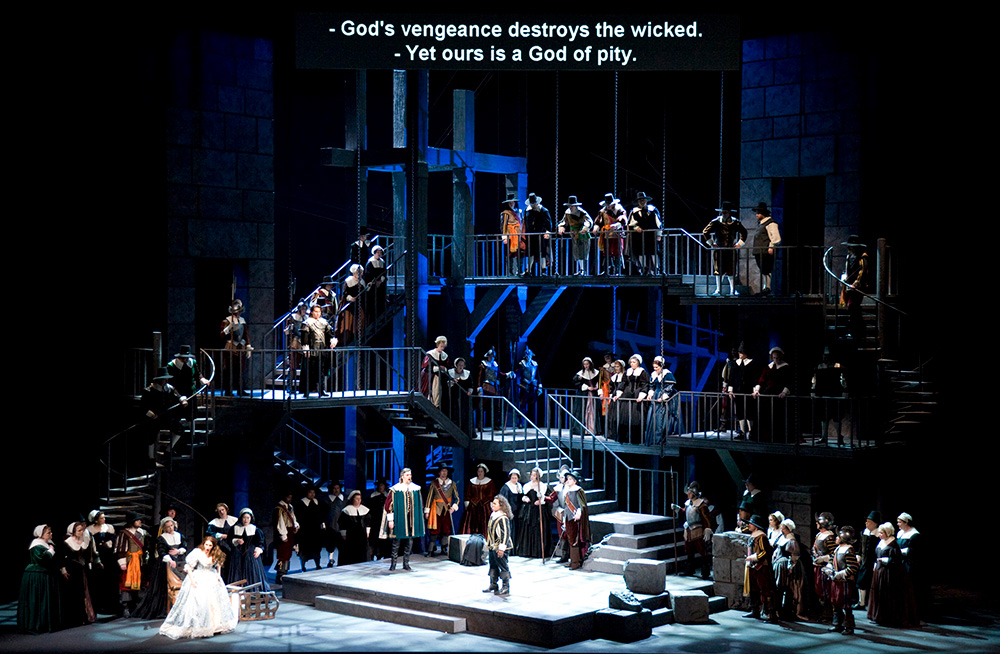
|
By Francesca Zambello
In my opinion, La traviata is just about perfect, musically and dramatically. There are some operas I never tire of and and this is one of them. I am always happy to open the score and study the words and the music again and again.
We expect to see singers and conductors revisit works multiple times, but this is less often the case with a director – she is more likely to create “her” Traviata, or Magic Flute, or Butterfly, making only minor adjustments as the production is revived in different houses and with different casts. It’s less common for a director to start over with a piece. But I’ve reimagined Traviata in houses ranging from Skylight Opera Theatre (where we billed it Lady of the Camellias, 1988) to Bordeaux (1998) to Sydney (2011) to the Bolshoi (2013) and now here.

|
| © Scott Suchman |
My first encounter with Traviata as a director was near the start of my career, when I prepared the “family matinee” cast for the San Francisco Opera. I remember being frustrated by the idea that this family performance – meant, in part, to introduce new audiences to the opera – would be sung in Italian and therefore be incomprehensible to many in the audience. Back then, “serious” operagoers would study an English translation of the libretto in advance of attending a performance. But how would we turn these new audience members into serious operagoers if they could not follow the story?

|
| © Rozarii Lynch |
It was the early 80s, and people were just starting to play with the idea of projected translations above the stage. The purists were in a furor, but I convinced the then General Director, Terry McEwen, that the family matinee was the perfect setting to experiment with titles. I worked with the stage manager, the late Jerry Sherk, to figure out a way to project translations from the lighting booth. Nowadays we just put everything into a computer program, but back then we had to make a literal “slide” of each line and load the slides into carousels like the ones we used to use to share photos from family vacations. Each carousel held no more than 80 slides, so we loaded up stacks of them, which had to be changed out during the performance. In the end, my direction for that production of La traviata was probably pretty work-a-day, but the reaction to the use of supertitles forever changed the San Francisco Opera audience.

|
| © Scott Suchman |
For this production, which we’ve set in Paris at the beginning of the 20th century, I wanted a straightforward take on the story, with perhaps one small twist. In the music of the prelude, Verdi gives us a glimpse of the story’s end, so I have followed his suggestion and presented Violetta’s story as a long flashback. We follow her from her deathbed to her lavish Parisian home, then to the countryside with Alfredo, and finally back to where we began. All the characters we see initially stay with us as we morph into different locations awaiting the inevitable.

|
| © Scott Suchman |
Since that family matinee in San Francisco, supertitles have revolutionized our art form. Taking in an opera’s story now requires no special preparation or background. At the same time, a truly great work like La traviata is an inexhaustible well. Like many long-time operagoers, I know every plot point and every tune by heart. But every time I encounter the piece, my ideas evolve, based on my own life experience, on what the cast brings to the piece, on the physical setting we choose, and on society’s changing views on women.
Whether this is your first opera or your twentieth Traviata, I welcome you to join me in exploring Violetta’s unforgettable journey.
La traviata runs May 6–21 at McCaw Hall. Tickets and info at seattleopera.org/traviata.



No comments:
Post a Comment